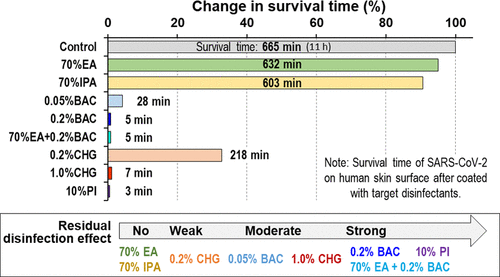
COVID-19:消毒剂的抗病毒残留消毒效果:京都府立医科大学
-“如何显着缩短病毒在人体皮肤上的存活时间”-
研究结果:
将消毒剂涂在手上并晾干后,
消毒效果如何?
我们建立了一个可以准确评估的模型。
乙醇、异丙醇等:
酒精类消毒剂几乎没有残留消毒作用。
另一方面,对于葡萄糖酸氯己定和苯扎氯铵等消毒剂,
残留消毒效果得到认可。
比较残留消毒效果:
“相对高浓度的0.2%苯扎氯铵”显示出特别强的残留消毒效果。
新冠病毒,
人冠状病毒,
流感病毒,
每个生存时间
665 到 5 分钟(小于 1%),
1285 到 12 分钟(小于 1%),
它从 121 分钟缩短到 4 分钟 (3%)。
这种强烈的残留消毒效果在涂抹于皮肤后可保持 4 小时。
大力支持手卫生:
将具有强残留消毒作用的消毒剂涂抹在皮肤上。
“这会形成一个病毒不太可能存活的皮肤表面。”
强烈支持当前的手部卫生。
它有望成为一种创新的接触感染预防方法。
https://www.kpu-m.ac.jp/doc/news/2021/20211127.html
日本研究团队发现的4小时效果“奇迹消毒剂” | 中央日报
https://s.japanese.joins.com/JArticle/285291?sectcode=400&servcode=400
Evaluation of the Residual Disinfection Effects of Commonly Used Skin Disinfectants against Viruses:
An Innovative Contact Transmission Control Method
Abstract
Lasting disinfection effects, that is, the residual disinfection effects (RDEs), of skin-coated disinfectants
have rarely been considered for infection control owing to the challenges involved in the accurate evaluation of RDEs.
In this study,
we constructed a new skin evaluation model and determined the RDEs of existing disinfectants against viruses.Our results showed that
ethanol and isopropanol had no RDE, whereas povidone–iodine, chlorhexidine gluconate, and benzalkonium chloride (BAC) exhibited RDEs,with 10% povidone–iodine and 0.2% BAC showing particularly strong RDEs.
The RDE of 0.2% BAC was strong enough to reduce
the median survival times of severe acute respiratory syndrome
coronavirus-2,
human coronavirus-OC43,
and influenza virus
from 670 to 5.2,
1300 to 12,
and 120 to 4.2 min, respectively.Additionally,
this strong RDE was maintained even 4 h after coating the skin.Clinical data also showed that the strong RDE of 0.2% BAC was maintained for more than 2 h.
Thus,
applying disinfectants with strong RDEs on the skin correlates with a reduction in virus survival timeand appears to create a skin surface environment that is not conducive to virus survival.
A prolonged reduction in virus survival decreases the contact transmission risk, thereby enabling stronger infection control.
Environmental Science & Technology